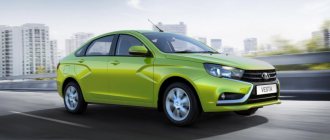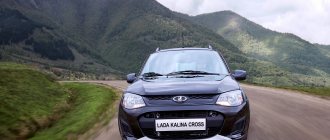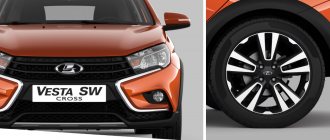A family car with a stylish design, a full range of options, a spacious trunk and a convenient automatic transmission - all this is the Lada Vesta SW Cross . To confidently compete with Korean and European manufacturers in the B-class, the domestic manufacturer relies on richer equipment for the same or less money, increased ground clearance for bad roads, winter options and a bunch of nice little things.
The best Telegram channel about technology (possibly)
Interesting fact: the abbreviation SW stands for Sport Wagon, that is, a sports station wagon.
I had at my disposal the most equipped version of the Luxe Prestige cross-station wagon with a 1.6-liter Alliance engine and a CVT for 1,056,000 rubles. In addition to the cross-wagon, the line includes a regular station wagon and a pair of sedans, each of which is equipped with one of three engines.
The most stylish B-class
With the release of the Lada Vesta, AvtoVAZ acquired its own recognizable X-style, aggressive and detailed: sharp lines, muscular wheel arches, branded stampings on the sides and a black insert on the rear pillar, creating the effect of a floating roof. In my opinion, the appearance of the LADA Vesta has not lost its relevance 5 years after the car was released.
The primary difference between the cross-station wagon is the increased ground clearance, 203 mm versus 178 mm for a regular station wagon. Externally, the car is distinguished by a plastic body kit, making the silhouette more rapid. Innovations give confidence on dirt roads and allow you to park next to any curbs, but the SW Cross should not be considered an SUV; there are no technical differences.
The head light is completely halogen with bulbs with a warm tint. The design of the headlights is correct; the light copes equally well with city twilight and night highways. In particularly difficult situations, fog lights with light creeping along the bottom help out. I especially liked the cornering lights, which light up the left or right fog lights when the steering wheel is slightly tilted.
The symmetrical rear optics also feature an X-shaped design. Despite the characteristic horizontal pattern, ordinary light bulbs are hidden inside, no diodes. The fog light is hidden in the center of the bumper. The light is controlled by the turn signal lever, but in real life you rarely have to use it - the automation works very correctly. As do automatic wipers with variable intervals. An interesting observation: when it rains, the rear wiper works automatically when reverse is turned on.
Huge 17-inch wheels on B-class cars are rare, but for the Vesta SW Cross they are part of the basic package. There is a 15-inch stowage space in the trunk niche.
Does the interior match?
Flip key with central locking remote control. From the inside, the central locking system is designed in an unusual way: no soldiers or latches, only a button with an indicator on the center console to lock the doors from the outside. If the car is closed, all doors open the first time from the inside, although they are closed from the outside. Moreover, when you open the front doors from the inside, the rear doors are automatically unlocked; when you open the rear doors, only the desired door is unlocked.
The front panel is complemented by non-marking gray inserts, the gloss is only around the multimedia system screen and the gearbox selector. There is little space for things, a couple of deep cup holders for large glasses and a small niche in the cigarette lighter area where a smartphone does not fit. I liked the design of the air deflectors and the separate air ducts directed towards the side windows. All the plastic is hard, but there are no creaks or “crickets”, the interior feels strong, even solid.
The lack of niches is compensated by a cooled glove compartment with a separate place for a service book, organizers for plastic cards and a pen.
The test car has a combined upholstery - eco-leather with dark fabric inserts. On the reverse side there is dark eco-leather, which is easy to wipe clean, with pockets in both seats. The driver's seat has height adjustment and a single-stage lumbar support, while the passenger seat has only standard adjustments - longitudinal and backrest tilt. The steering wheel is adjustable for both angle and reach. Tall drivers may not have enough range to adjust the reach of the steering wheel, which results in two borderline situations: either it’s comfortable for the legs, but you need to reach for the steering wheel, or vice versa.
The head unit with a 7-inch screen, in addition to radio, supports Bluetooth, as well as playing music and video from a flash drive and AUX. Speakerphone with dialing capability is available, Apple CarPlay and Android Auto are missing. CityGID is used as a navigation system. There are no complaints about the device, it simply performs basic functions, has a display that is readable in any conditions and a responsive resistive sensor. Users of Yandex services will like the ability to replace the head unit with the Yandex.Auto system with a navigator and music. There are 6 speakers installed from the factory: mid-range and tweeters in front, and only mid-range in the back. The sound is clean and surprisingly pleasant, only the low frequencies suffer.
In the niche under the head unit there is a low-current USB for flash drives and a cigarette lighter socket. To charge your smartphone, it is better to use the rear USB or a separate cigarette lighter adapter.
Between the seats there is a soft armrest without height or reach adjustments. Under the lid is a small box with a rubberized mat; the volume is enough to store a charger and a couple of USB cables.
The front door panels have short, hard armrests that make the arm rest uncomfortable. But the pocket can accommodate a 1.5-liter bottle, and there is still room for small items.
All windows are electric, but without closers. You have to get used to the stiffness of the buttons. A special feature of the package is that the mirrors automatically fold with a button; the drive operates even when the engine is turned off or when the lock button on the key is held for a long time.
Passengers have the same hard buttons without closers on each door card.
The climate is single-zone with buttons for setting directions and adjusting the temperature in 1-degree increments. The stove quickly begins to blow warm air, the blowing is quite powerful and quiet - it remains barely audible up to speed 3-4. But there is a problem with the logic: it is impossible to turn on automatic mode or maximum windshield airflow without air conditioning, since these functions are only activated in parallel.
Separately, I would like to note the complete set of winter options. All seats, including the rear ones, are heated with more intense heating in the lumbar area. The heated steering wheel operates over the entire area, especially noticeably in the grip areas. The threads of electric heating of the windshield are visually noticeable, but do not tire the eyesight.
Pleasant attention to detail is manifested in the lighting: all the buttons throughout the cabin, door handles, front foot wells, a niche for a 12-volt socket, as well as the ground when opening the doors. All interior lighting is modern LED, there are lampshades both front and rear.
For rear passengers there is a central armrest with a pair of cup holders - an unprecedented option for the B-Class. In addition, in the rear there are optional heated seats, a USB connector for charging equipment and a 12-volt outlet. Taking into account the equipment and the large amount of leg and head space, the Lada Vesta SW is a very comfortable car for rear passengers. Among the shortcomings are short, hard armrests on the door panels and a high tunnel in the center, which interferes with the third passenger.
Bonus gallery with photos of the salon.
The trunk is the pride of the station wagon
The rear door opens with a separate rubberized button next to the rear view camera. For ease of closing, there are a pair of handles: no need to clap, just push - the door closes softly under its own weight.
The spaciousness and convenience of the trunk are the pride of the owner of the Vesta SW station wagon: 480 liters are complemented by organizers and niches, standard hooks require the installation of two nets. The luggage is covered with a soft curtain with a spring-loaded closer. The seats recline 60/40, with a large section on the passenger side, allowing you to carry large loads without moving the driver's seat.
The luggage compartment is well organized: on the left there is a place for washer fluid or oil with a belt, on the right there is a niche for the compressor, there are hooks for bags on both sides, and there is a cigarette lighter socket. The floor is double, there are molded compartments under two covers. Attention to detail, the covers of the organizers are fixed in the open position on hooks.
DIMENSIONS OF LADA VESTA
It was not for nothing that Bo Inge Andersson said that in terms of size, the Lada Vesta will be one of the leaders in the class, which will largely ensure its popularity. That’s right, strictly speaking, the car is difficult to unambiguously classify as segment B, since it is at the junction of classes B and C. The length of the sedan is 4,440 mm, with a width of 1,764 mm and a height of 1,497 mm, and this is noticeably longer than the Hyundai Solaris (4,375 mm, 1,700 mm and 1,470 mm), which is one of the main competitors of the Russian car.
The wheelbase of the Lada Vesta is 2,570 mm, and the track of the front and rear wheels is slightly different - 1,495 mm and 1,502 mm, respectively. The ground clearance of the new product is traditionally higher than that of foreign cars and is equal to 171 mm under the crankcase of the power unit, provided it is fully loaded, and also 144 mm, subject to change under the engine mudguard. This, together with a front overhang of 860 mm and a rear overhang of 915 mm, as well as approach and departure angles of 16.6° and 14.2°, provides the ability to confidently drive on country roads, which is important for residents of small towns.
The luggage compartment of 480 liters of usable volume is also one of the most spacious in the class, and the payload of 487 kg allows you to take a lot of luggage “on board”. Vesta's curb and gross weights are 1,178 kg and 1,653 kg, respectively. But the distribution of curb and total weight along the axles is different. In the first case it is 60/40, and in the second – 52/48. Regarding towing a trailer, the permissible weight for a device equipped with brake mechanisms is 900 kg, and for one without brakes - only 450 kg.
It's time to drive!
The driver is greeted by a three-spoke steering wheel; the leather has a clearly visible texture and perforations in the grip areas. On the left are the cruise control buttons, on the right are multimedia, telephone and heating.
The instrument panel is divided into three wells with a large speedometer in the center and separate scales for temperature and fuel level. The orange background adds sporty aggression, the large bold font is easy to read, but the style is controversial, among my friends opinions are polarly divided. An unusual feature is the sound signals when the fuel level is low and when operating the cruise control. Below the speedometer is an overly simple trip computer with a two-line screen. I would like to note the display of instantaneous consumption when the car is stationary in liters per hour; it is convenient to use it to determine the degree of warming up of the car: you can start moving when the indicator drops to 1.1-1.2 liters per hour. In real life, a digital speedometer is sorely missed.
Despite the multifunction steering wheel, the on-board computer is controlled by two buttons on the end of the wiper lever. In a B-class car, you would like to see a larger screen with more intuitive control of the buttons on the steering wheel.
The two-pedal Vesta has an ergonomic miscalculation - the absence of a stand for the left foot. In its place is carpet, so you have to make a difficult choice: either tuck your foot in or stain the upholstery.
The noise insulation is pleasantly impressive; the cabin becomes noisy only after 60-80 km/h; the doors, arches and roof have clearly been treated. The engine is inaudible even at speeds above 3-4 thousand, the engine shield is covered on the engine side, and there is thermal insulation on the inside of the hood. According to my subjective impressions, the acoustic comfort of Vesta SW Cross is superior to competitors from the B-class and can compete with some representatives of the C-class.
Visibility and sense of size are good, you instantly get used to the Lada Vesta SW Cross. At first, the small area of the rear window is confusing, but the assistants compensate for this. Namely, using a rear view camera with dynamic trajectory lines, you can navigate not only during the day, but also at night; additionally, sound signals from the rear parking sensors help.
TRANSMISSIONS
In this regard, AvtoVAZ also offers a wide choice. The main gearbox will be a 5-speed manual, which is also installed on other VAZ models. In 2012, it was modified, some components were replaced, Japanese and German parts were supplied, the volume of oil poured was reduced, and other work was carried out. As a result, the gearbox is quieter, shifts have become more convenient, and vibrations have decreased.
Technical characteristics of Lada Vesta gearboxes.
The Lada Vesta will not receive a classic automatic transmission, which has upset many visitors to dealer showrooms. Its place was taken by a “robot” of the AMT type, due to its low cost of production, created on the basis of a manual gearbox bearing the index 2180. Despite the rougher work (small jerks and jolts when switching), the use of components from the world companies ZF and VALEO, coupled with less appetite and no need to warm up, the robot has a real chance of becoming a worthy alternative to an automatic transmission.
Weight of Lada Vesta engines and gearboxes.
In addition, the Lada Vesta will also receive a CVT, which will be transferred to the domestic sedan from the Japanese model Nissan Tiida. However, there is no more complete information on it yet.
Nominal filling volumes of Lada Vesta (in liters).
Geek block
The base sedan debuted in 2015, the station wagon, including the cross version, joined in 2022. In 2022, the entire family received an intermediate update, bringing a version with a CVT, new power-folding mirrors, a heated steering wheel, new door stops and deeper front cup holders. The whole family gathers at the Izhevsk AvtoVAZ site.
The Laba B platform is front-wheel drive with a transverse power unit. The tested car is equipped with a Nissan-Renault HR16DE-H4M engine, which has been assembled in Togliatti since 2015. This is a simple 1.6-liter naturally aspirated engine with 113 horsepower and 152 Nm of torque. The unit is aluminum with cast iron liners, distributed injection, a phase shifter on the intake shaft and a timing chain drive. The only negative aspects include the lack of hydraulic compensators; valve clearances will have to be adjusted at a service station once every 80-100 thousand kilometers.
The imported engine is coupled with a Japanese continuously variable transmission Jatco JF015E, a robot with one AMT clutch in the past. The V-belt variator is complemented by a torque converter, which acts as a clutch, and a two-stage planetary gear to reduce the size of the cones and, accordingly, the dimensions of the unit. The complex design of the CVT box is demanding on oil purity; it is better not to neglect the recommended replacement interval of 40,000 kilometers. I liked the performance of the transmission: the variator is able to maintain optimal engine speeds, acceleration is absolutely smooth, and when you release the gas at speed, the car simply rolls and does not “nod off.”
As an alternative to the French-Japanese units, domestic engines are offered, a 1.6-liter with 106 horsepower under the index 21129 and a 1.8-liter with 122 horsepower under the index 21179, equipped with domestic mechanics. The engines are the closest relatives: cast iron block and aluminum cylinder head, 16 valves, timing belt drive and distributed injection. The increase in volume of 21179 is achieved by increasing the piston stroke, the second difference is the phase shifter at the inlet. Both 21129 and 21179 have their roots in the previous 16-valve AvtoVAZ engines. The gearbox is a five-speed manual transmission with a cable drive under the designation VAZ 21807. This gearbox is quieter than the one installed on the Grant, but the characteristic howl in second gear and the specific sound of the rear gear are inherited - these are family traits of boxes from Togliatti.
All engines run on inexpensive AI-92 gasoline. The tested version with a 1.6-liter naturally aspirated engine and a CVT turned out to be quite economical. In the combined cycle, with an advantage in favor of the city, with quiet driving and overtaking, consumption was 8.2 liters per 100 kilometers. In exclusively urban mode with constant traffic jams, consumption increased to 9.6 liters, if you drive aggressively - up to 10 liters. A free city with rare traffic lights, smooth acceleration - 7 liters. When driving on the highway at speeds of 80-100 km/h, you can achieve 6.7 liters per 100 kilometers. The fuel filler flap has a spring-loaded latch and is automatically locked with a central lock.
The front suspension with L-shaped arms is assembled on a rigidly fixed subframe, the rear suspension is spring with a semi-independent beam. The raised SW Cross on 17 wheels with a low profile is far from the standard of softness. The suspension is very collected, but not shaking: it does not break through potholes, tram tracks are overcome quietly and without blows to the spine, no extraneous knocks or unnecessary shaking in any conditions. For drivers looking for softness, I recommend smaller wheels with a higher profile.
Lada Vesta has sharp, informative handling with a slightly blurred zero and pleasant reactive effort. The effectiveness of the electromechanical amplifier depends on the speed of movement. The rack and pinion steering is mounted on a subframe, so vibration from impacts on the suspension is not transmitted to the steering wheel. The driving experience is very pleasant, with confidence in every maneuver - this is an excellent level for the B-Class. Driving habits do not compromise safety; the Lada Vesta SW Cross is stable on straight lines and predictable in corners. Vesta with a 1.6-liter engine and a CVT accelerates to the first hundred in 12.2 seconds, the dynamics correspond to a calm city car that allows you to keep up with city traffic, drive relatively quickly on the highway and make infrequent overtaking.
Front and rear disc brakes. The pedal travel is predictable, the braking process is soft, at high speeds there is no fear of not stopping - there is a reserve. However, the rear disc brakes have a factory miscalculation that leads to squeaking and howling when moving backwards. The problem is solved by installing alternative rear pads.
Factories in Russia. First step: Lada Vesta first passed through the assembly line of the Izhevsk plant
On November 5, the VAZ press service released a message: a trial Lada Vesta body was welded at the Izhevsk Automobile Plant. This is the first purely production step in the fate of the model. There are still at least three months before the pilot copies of Vesta appear, but development of the “finishing” technology of welding, painting and assembly is already beginning. And in parallel, prototypes (the so-called S-lot) are being built at VAZ, which will be sent for testing.
Let's look at what has been done to date and what needs to be done in the near future. Let's take a look, so to speak, behind the scenes of the action taking place at the plant in Izhevsk.
VAZ received the first batch of stamped parts for welding the Vesta body back in September. The “iron” was manufactured abroad, in companies that were ordered to produce stamping equipment. As a matter of fact, these are the first “impressions” from finished stamps. To speed up the process, they were sent by plane. And the molds themselves will sail for several weeks across seas and oceans from South Korea and Japan.
The Lada Vesta body (factory index - LADA-2180) consists of 245 parts, divided, in turn, into 927 dies. For convenience, “bodywork” is divided into small, medium and large. The latter includes floor panels, front panels, etc. The order for the production of molds and test “prints” was received by the Korean companies LG, MS Autotehc and CES, as well as the Japanese Ogava Seiki. It was the Japanese who had the honor of making the equipment for the largest and most significant parts of the Vesta body (239 stamps).
The stamped panels “flew” to Tolyatti, where the main blanks were welded from them by UEP. UEP is the Experimental Production Department, located on the territory of the VAZ EPP. If OPP is formally a thread of the main conveyor, then UEP is a factory within a factory, a site with the most modern equipment for the production of pilot batches or even just single copies of experimental cars. The UEP was organized and equipped quite recently; Vesta is the first big job for it. At UEP, VAZ and Izhevsk engineers worked together to weld the first parts.
So, at the VAZ we welded the base of the floor and the assembled body - frame, doors, hood and trunk lids, etc. And all this went to Izhevsk, where by that time one welding section had been modernized so that it was possible to work using bypass technology - without geometric equipment. And on November 4, the first Lada Vesta body in the history of mankind was manufactured.
It must be said that at the Izhevsk plant there are now two welding lines operating in parallel - the old one, which was modernized for Grant, ...
...and a new one, built for Nissan and, in the future, Renault.
Of course, Vesta will be made on a new line (AIMS 1), together with Nissan Sentra. It cannot be said that it is very modern - the bodies here are welded mainly by hand, by conductors.
And only at the end of the line are four Fanuc robots, “assembling” the body from large blanks. More precisely, robots on the finished frame weld points on the sills, arches, roof and front end.
Another hefty manipulator removes the finished body from the line and places it on a special technological trolley, on which the frame is sent to the line of mounted units. This colossus has a nickname - Godzilla. Moreover, which is typical, the Japanese themselves call it that!
That's all nanotechnology is, as Anatoly Chubais would say. On the old welding line, the degree of automation will be noticeably higher.
A significant amount of robotics is used in the welding of Granta's body
There is also a warehouse for stamped parts; it is now being optimized to provide shelving for Vesta. They are also preparing additional stations for the sub-assembly of complex parts - doors, hood covers, floor parts, sidewalls, etc. Here, in the free areas, all this will be located.
All rolling and welding equipment is similar to what Nissan uses now. This is how doors are made:
Door sub-assembly area
Rolling robot
Here the mastic for rolling is prepared
Welding the door frame
Finished door without front panel
The first body of Vesta, as it is easy to assume, was not driven along the entire welding line, but only along its final section, where the robots are located. The main task was to check the control program and debug it. It is impossible to hit all the welding points perfectly the first time; several approaches with subsequent correction are required. With manual welding, everything is simple - clamp the part into the jig, take the pliers... But robots require fine tuning, because the tolerance fields “play” depending even on the quality of the molds. The first welding generally went like this: the pliers were brought in manually and commands were given for welding pulses. This case was photographed and the materials were sent to programmers so that they could write optimal trajectories for the robots. The percentage of getting into the mathematical model the first time is always small, within 10-20%. It must be clarified: these are not errors in determining the welding location, but falling within the tolerance zone, which for Vesta is 1.5 mm. The matter was aggravated by the fact that there are no special “West” mites in Izhevsk yet; they will be brought in in January. So we had to make do with Nissan ones. However, this was how it should have been according to plan.
Other welding operations in Izhevsk will be carried out only at the stage of construction of S-lot 2 samples, from mid-February 2015. This will be 28 bodies. Then there will be two pre-production batches (30-40 pieces each). Then they will check the readiness of not only the welding line, but also the assembly line.
But with the coloring everything turned out great. A “finishing” correction of the programs for the robots may be required, but the coatings on the first body are already working well. And cataphoretic primer, and enamel with varnish, and anti-noise mastic for the bottom. Three weeks of software debugging yielded positive results. During the painting and drying process, the first body was covered with thermal sensors and the layers were checked for uniform drying - everything was fine.
As already announced, Vesta will be painted in nine different colors, three of which are shared with Nissan.
This is the room where enamels are prepared.
14 stations on the assembly line are being modernized. But in general, the assembly of Vesta, broken down into operations, will hardly differ from that for other models of the plant in Izhevsk. Here is Vesta's first pass along the assembly line (although, to be honest, it was the second - it was organized especially for me).
The workers examine Vesta with interest, pointing their fingers, marveling at the unfamiliar design. Very soon they will have to master the assembly of this model.
And all this is observed by the director of the Lada Vesta project in Izhevsk, Dmitry Zverev:
Dmitry Zverev, director of the Lada Vesta project in Izhevsk
Vesta's production is breaded using the most complete cycle, with its own stamping and a high degree of localization of plastic parts.
While the molds are being made, a platform for new presses, also South Korean, is being prepared in the corresponding workshop.
Panels will be made here not only for Vesta, but also for Nissan. According to Vesta - 61 positions, mostly medium stamping. And all the other hardware will come from VAZ, it’s more profitable.
This is what the current press production looks like today:
And this is a workshop for the production of plastic parts.
Luxurious injection molding machines, stands for vibration welding, robots for cutting soft plastic... This workshop was also launched recently, at the beginning of this year, and it feels like they didn’t skimp on equipment.
For Vesta, they plan to make most of the parts in Izhevsk - bumpers, interior elements, a total of 113 parts and assemblies. According to some information, the companies Poliplastik and Basell have been nominated for the project, but Izhevsk residents claim that they can handle it themselves.
The plant will also produce seats. Formally, this is already the area of responsibility of Lear, which simply rents a small workshop from the plant in an old building, where the body of the first Izhevsk Moskvich-408 was welded in 1965.
Now let's return to the Lada Vesta launch schedule.
These signs hang above the main conveyor
Assembly of the first car is scheduled for February 22, 2015. And by the end of summer they will make about two hundred cars.
All “pilot” samples of Vesta will be used for predetermined tests - resource, road, and crash tests. Each sample has its own individual schedule already prepared. Of course, after testing they will be disposed of.
There are, let’s say, three and a half aggregate configurations for Vesta. The base engine will be the VAZ-11189 - a further modernization of the current 87-horsepower eight-valve engine. This engine will only be coupled with a manual transmission.
The next step is the VAZ-21129 engine, an evolution of the 16-valve engine with a power of 106 hp. It will be combined with both “mechanics” and “robot” (AMT 2182).
And at the top of the range is Nissan’s 114-horsepower HR16DE-H4M engine with a JH510 manual gearbox. This power unit will begin to be assembled at VAZ, displacing the “renowned” K4M.
The first to go into production will be Vesta with a 106-horsepower engine; it will be presented as a production model on September 25, 2015. The certification of the model with an eight-valve engine is planned to be completed in mid-October of the same year, and with the HR16 engine - in December. So the most powerful and expensive Vesta will not appear in car showrooms before February 2016.
Amazingly, Vesta’s launch hardly deviates from plan. Yes, there were delays in the supply of stampings from South Korea, which is why the production schedule for the “pilots” had to be rewritten. But now everything has settled down and returned to normal.
Vesta is the first VAZ car on the new platform in God knows how long. After all, all current front-wheel drive models, by and large, are just derivatives of the old “eight” platform, with archaic solutions such as the absence of a front subframe or a top-mounted steering rack. And Vesta has a completely modern design, largely inherited from the famous Project C. I had the opportunity to communicate quite a lot with the creators of Project C and Lada B (as Vesta was called in the early stages). Some no longer work at VAZ... So, they created a truly new and original design, there is no shame in it. Even taking into account the fact that the main structural elements of Vesta were developed seven to eight years ago.
Original front suspension with L-shaped arms, new steering knuckles and five-degree caster. Front subframe with a steering rack mounted on it with electric power steering on the shaft. Steering column adjustable for tilt and reach of the steering wheel. The longest wheelbase in the history of serial VAZ models is 2620 mm (2635 mm according to other sources), we don’t count the long wheelbase Niva-2131, it’s a different class. Design torsional rigidity - 15,000 N.m/deg. In general, Vesta looks like a completely modern car in its basic parameters.
And what’s most interesting is that Vesta will be the first model whose production is prepared entirely according to the standards of the Renault-Nissan alliance.
This makes some people sad. Some people find it reassuring. But everyone is waiting for Vesta with at least curiosity.
Review - so what's the end result?
If we summarize our impressions of the Lada Vesta SW Cross , a simple conclusion suggests itself - it is a very stylish and recognizable, well-equipped and easy-to-drive competitor to imported representatives of the B+ class. Without any exaggeration, Vesta destroys prejudices regarding passenger cars from Tolyatti. Despite all the positive things, Lada engineers should pay attention to a huge number of little things: it is necessary to correct the annoying hum from the rear brakes when reversing, and then bring the options to a modern level. First of all, add automatic windows, replace the on-board computer, work on the ergonomics of the door cards and add a platform for the driver’s left foot.
Pros:
- recognizable appearance;
- practical body type with a spacious trunk;
- high ground clearance allows parking close to curbs;
- thoughtful trunk space;
- driver's habits on the road;
- good equipment;
- an easy-to-handle combination of a 1.6-liter engine and a CVT;
- use of less expensive AI-92 gasoline.
Minuses:
- howling when reversing;
- a small on-board computer with inconvenient controls and no digital speedometer;
- lack of power window closers.
May not like:
- lack of platform for the driver's left foot;
- problems with the ergonomics of door cards.











